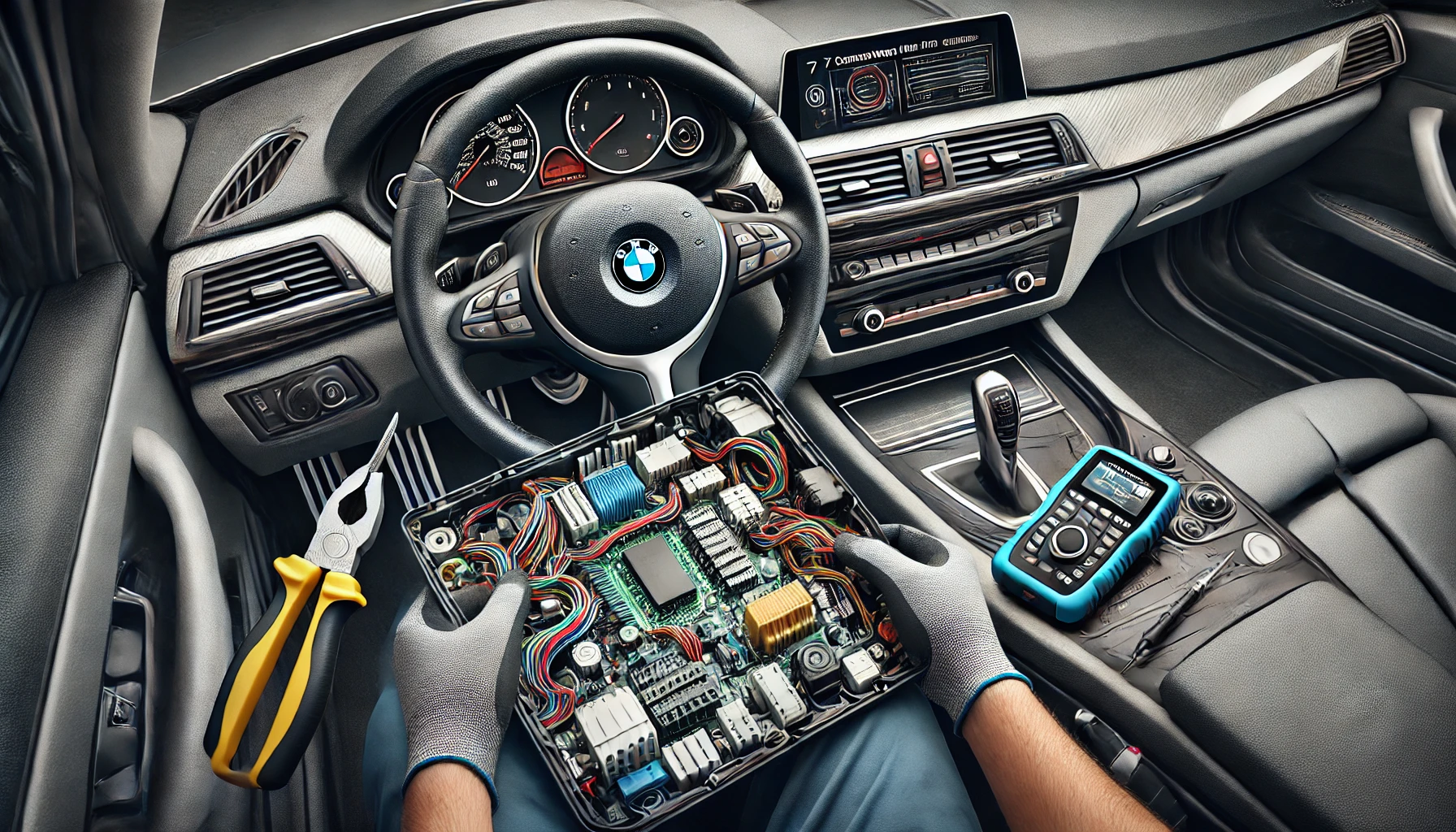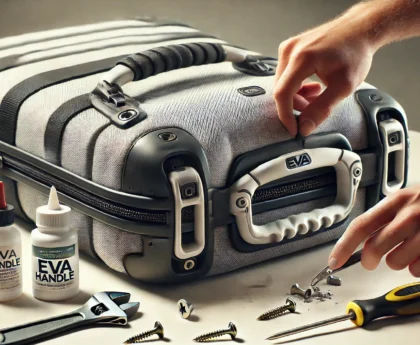Introduction
What is the BMW E90 FRM?
The BMW E90 FRM, or Footwell Module, is an important part of your car’s electrical system. This module controls many things, such as your car’s lights, windows, mirrors, and other key functions. It is the brain behind these features, helping them work smoothly and efficiently.
In simple terms, the FRM makes sure that when you press a button, the desired function happens. For example, when you roll down a window or switch on your headlights, the FRM manages these commands. If the FRM fails, many electrical parts in your BMW E90 might stop working properly, making it a very frustrating issue for owners.
Why FRM Issues Are Common in the BMW E90?
Many BMW E90 owners experience problems with the FRM. This is because of a few reasons. Firstly, the FRM is sensitive to voltage changes, such as when the battery is weak or the car is jump-started. Secondly, as the car ages, the wiring and the module itself wear out, which can lead to failure. Lastly, short circuits or power surges can damage the FRM, causing it to malfunction.
Understanding the BMW E90 FRM and how it works is the first step toward fixing any issues. Knowing how this module operates will help you identify common problems and fix them quickly, ensuring your car’s electrical system runs smoothly.
Understanding BMW E90 FRM Failures
Why Does the BMW E90 FRM Fail?
The BMW E90 FRM can fail for several reasons, and it’s important to understand the most common causes to address them quickly.
- Electrical Overloads and Short Circuits
The FRM is vulnerable to electrical overloads or short circuits. These can happen if the car’s wiring is damaged or if there is a sudden surge of electricity. Such surges can cause the module to stop functioning, leading to electrical issues in the car. - Impact of Voltage Drops and Power Surges
One major issue with the BMW E90 FRM is its sensitivity to voltage drops or power surges. If the battery is low or the car is jump-started, the FRM can be exposed to unstable voltage. This fluctuation can cause the module to malfunction or fail completely. - Aging and Wear Over Time
Like any other component, the FRM wears out over time. As the car ages, the electrical parts, including the FRM, become less reliable. Constant use and exposure to different conditions can lead to failure, making it a common problem in older BMW E90
Symptoms of BMW E90 FRM Failure
Knowing the signs of FRM failure can help you identify the problem early and take steps to fix it.
- Lights Not Working or Malfunctioning
One of the first signs of FRM failure is malfunctioning lights. You may notice that the headlights, tail lights, or interior lights are not working correctly. In some cases, they may flicker or not turn on at all. - Windows Not Rolling Up/Down
Another common symptom of a failing FRM is when the power windows stop working. You may find that you cannot roll the windows up or down, or they may only respond sporadically. - Dashboard Errors or Warning Lights
If the FRM is malfunctioning, your dashboard may display error messages or warning lights. These can include messages related to the car’s electrical system, lighting, or other components that the FRM
Recognizing these symptoms early can save you from larger electrical issues and help you fix your BMW E90 FRM before it causes more significant problems.
Diagnosing BMW E90 FRM Problems
Tools Needed for FRM Diagnosis
Before diagnosing BMW E90 FRM problems, you need the right tools. Having the correct equipment makes it easier to pinpoint issues and find a solution.
- OBD Scanners and Diagnostic Software
The most essential tool for diagnosing FRM issues is an OBD scanner. This tool connects to your car’s onboard computer and reads error codes. Many OBD scanners come with diagnostic software that helps you understand the specific problems related to the FRM. - Understanding Error Codes Related to the FRM
Once you scan the car using an OBD tool, the system will show specific error codes. These codes are crucial because they tell you exactly what is wrong with the FRM. Understanding these codes helps in identifying whether the problem is a minor reset issue or if the FRM needs reprogramming or replacement.
Step-by-Step Guide to Diagnose FRM Issues
Diagnosing BMW E90 FRM issues can be done at home with the right tools and a bit of patience. Here’s a simple guide to help you through the process.
- How to Use Diagnostic Tools to Identify FRM-Related Errors
-
- First, connect your OBD scanner to the car’s port, which is usually located under the dashboard.
- Turn on the car and let the OBD scanner read the system. This may take a few moments.
- Once the scan is complete, the tool will display error codes related to the FRM and other parts of the car.
- Use the diagnostic software or an online error code database to understand what each code means.
- If the error codes point to FRM failure, you will know whether the module needs to be reset, reprogrammed, or replaced.
- When to Seek Professional Assistance
If you don’t have the tools or experience, it’s always smart to seek professional help. Here are signs that you should take your car to a mechanic:
-
- If the error codes are complicated or unclear.
- If resetting or reprogramming doesn’t fix the issue.
- If you are uncomfortable working with your car’s electrical system.
A professional mechanic will have the necessary tools and knowledge to diagnose and fix BMW E90 FRM issues effectively, ensuring the problem doesn’t return.
Common Fixes for BMW E90 FRM Issues
Resetting the FRM Module
One of the first things you can try when facing BMW E90 FRM issues is resetting the module. This is often a simple fix that can solve minor glitches.
- How to Reset the Module Using Diagnostic Software
To reset the FRM module, you will need BMW-specific diagnostic software like INPA or ISTA. Here’s a step-by-step guide:
-
- Connect the diagnostic tool to your car’s OBD port.
- Open the software and navigate to the FRM section.
- Select the option to reset the FRM or clear any error codes related to it.
- Once done, restart your car and check if the issues are resolved.
- When Resetting Works and When It Doesn’t
Resetting the FRM is useful for temporary glitches or minor electrical faults. If the module was overloaded due to a battery change or voltage surge, resetting it can bring everything back to normal. However, if the FRM has suffered major damage or has corrupted firmware, resetting won’t fix the problem, and you’ll need to explore other solutions like reprogramming or replacement.
Reprogramming the FRM
If resetting the FRM doesn’t solve the issue, reprogramming might be the next step. This process involves updating the module’s software to restore its functionality.
- Steps to Reprogram the FRM Using BMW Coding Tools
-
- Use a BMW coding tool like NCS Expert or ISTA-P.
- Connect the tool to the car’s OBD port.
- Load the car’s model information and navigate to the FRM module.
- Select the reprogramming or coding option.
- Follow the on-screen instructions to reprogram the module. This can take several minutes.
- Once completed, restart the car and check if the FRM is working properly.
- Risks Associated with DIY Reprogramming
While reprogramming can fix many FRM issues, it’s not without risks. If the coding process is done incorrectly, it can corrupt the software, causing more severe problems. DIY reprogramming also requires a certain level of technical knowledge. If you are unsure, it’s best to leave this to a professional.
Replacing the FRM Module
In some cases, the FRM module is too damaged to be reset or reprogrammed. When this happens, replacement is the only solution.
- Cost of Replacement
Replacing the FRM module can be expensive, depending on whether you choose to buy a new module or a used one. New modules from BMW can cost between $300 to $700, not including labor. A used or refurbished FRM can be more affordable, but you’ll need to ensure it’s compatible with your vehicle. - How to Install a New FRM Module
Installing a new FRM module usually requires professional help, but here’s a basic overview of the process:
-
- Disconnect the battery to prevent electrical damage.
- Locate the FRM module, which is usually positioned under the dashboard on the driver’s side.
- Carefully remove the old FRM module and install the new one.
- Once installed, the new module will need to be programmed to work with your specific vehicle, using BMW coding tools.
- Reconnect the battery and test the car to ensure the module is working correctly.
If you prefer not to do this yourself, a mechanic can handle both the replacement and the reprogramming of the new FRM module. This ensures a smooth and reliable repair.
Preventing Future FRM Failures
Taking preventive steps can help you avoid BMW E90 FRM issues in the future. By maintaining your car’s electrical system and being mindful of power-related issues, you can reduce the chances of experiencing FRM failures.
Regular Maintenance Tips
Regular maintenance is key to ensuring the longevity of your FRM module. Here are a few simple steps you can follow to keep it in good working order:
- Voltage Regulation Checks
One of the main causes of FRM failure is sudden voltage changes. Regularly checking your car’s voltage levels ensures that your electrical system is functioning within the proper range. If you notice any irregularities, it’s important to address them before they cause damage to the FRM. - Avoiding Battery Drainage and Power Surges
To prevent FRM failures, make sure that your battery is always in good condition. Avoid letting the battery drain completely, as this can cause power surges when the car is started again. Jump-starting the car frequently or using low-quality batteries can also lead to power surges that may damage the FRM module.
Installing Voltage Surge Protectors
A more advanced step for protecting your BMW E90 FRM is to install a voltage surge protector. These devices help regulate the electrical flow in your car, preventing spikes that can damage the FRM and other sensitive components.
- Benefits of Using Surge Protectors for FRM Longevity
Surge protectors can greatly extend the life of your FRM module. They act as a buffer, absorbing any sudden spikes in voltage and protecting the FRM from overloads. This is especially useful if you drive in conditions where power surges are common, such as during frequent battery changes or jump-starts. By investing in a surge protector, you can reduce the risk of future FRM failures and save on repair costs in the long run.
Taking these preventive measures will help ensure that your BMW E90 FRM functions properly for years to come, giving you peace of mind and avoiding costly repairs.
Professional Help for BMW E90 FRM Repairs
While some BMW E90 FRM issues can be fixed with basic tools, there are situations when it’s better to seek help from a professional mechanic. Knowing when to call for expert assistance can save you time and prevent further damage.
When to Contact a Professional Mechanic
- Signs That a DIY Fix Might Not Be Enough
If you’ve tried resetting or reprogramming the FRM without success, it’s time to consult a professional. Some signs that a DIY fix may not be sufficient include:
-
- Persistent error codes even after resetting the FRM.
- Electrical components, such as windows or lights, not functioning even after reprogramming.
- Difficulty accessing or using the necessary BMW coding tools.
- Concerns about handling delicate electrical systems without proper experience.
- Finding Certified BMW Repair Shops for FRM Replacement
It’s important to take your BMW E90 to a certified BMW repair shop. These shops have experienced technicians who are trained in diagnosing and repairing FRM They will also have access to the proper software and tools for resetting, reprogramming, or replacing the FRM module. You can find certified BMW repair shops through BMW’s official website or by searching for authorized service centers in your area.
Estimated Costs for FRM Repair and Replacement
- Typical Costs for Diagnosis, Reprogramming, and Replacement
The cost of fixing an FRM issue can vary depending on the extent of the problem. Here’s a breakdown of what you might expect:- Diagnosis: Professional diagnosis using advanced diagnostic tools typically costs between $100 and $200. This includes reading the error codes and determining if the FRM needs to be reset, reprogrammed, or replaced.
- Reprogramming: If your FRM only needs reprogramming, this service can cost anywhere from $150 to $300, depending on the shop and the complexity of the coding required.
- Replacement: If the FRM module is damaged beyond repair and needs to be replaced, the cost can be much higher. A new FRM module typically ranges from $300 to $700, with labor charges adding another $200 to $400, making the total cost for replacement between $500 and $1,100.
It’s always a good idea to get a quote from several certified BMW mechanics before proceeding with any repairs. This ensures you get a fair price and quality service for your BMW E90 FRM repairs.
FRM Software Updates
Keeping your BMW E90 FRM software up to date is crucial for the smooth functioning of your car’s electrical system. Regular updates can improve performance, fix bugs, and prevent future FRM failures.
Why Updating FRM Software is Important
- Benefits of Staying Up to Date with BMW’s Software Updates
BMW regularly releases software updates to improve the performance of the FRM module and other components. Updating the software can help resolve minor issues, enhance the module’s efficiency, and even prevent future malfunctions. Regular updates ensure that your FRM is running the latest, most stable version, reducing the risk of errors and failures. - How to Check for the Latest FRM Software Updates
To stay updated with the latest software releases from BMW:
-
- Check your vehicle’s service manual or BMW’s official website.
- Visit a certified BMW dealership or repair center, where they can check if your car’s FRM software is up to date.
- Use BMW’s diagnostic tools, such as ISTA or INPA, to connect to your car’s system and check for available updates.
How to Update BMW FRM Software
If your FRM software is outdated, here’s a simple guide to updating it using BMW software tools:
- A Step-by-Step Guide for Software Updates Using BMW Software Tools
- Connect a BMW Diagnostic Tool
You will need a BMW coding tool like ISTA or INPA, and a cable to connect your laptop to your car’s OBD port. - Turn on the Ignition
Make sure your car’s ignition is on, but do not start the engine. Connect the tool to the OBD port located under the dashboard. - Access the FRM Module
Open the diagnostic software and navigate to the FRM module The software will scan the current version of your FRM and check for updates. - Download and Install the Update
If an update is available, the software will prompt you to download and install it. Follow the on-screen instructions to complete the process. This may take several minutes. - Restart the Car
Once the update is installed, restart your car and check if the FRM module is functioning correctly.
By regularly updating your BMW E90 FRM software, you can ensure the module operates efficiently and minimize the risk of electrical issues. This simple preventive measure helps keep your car in top condition, reducing the likelihood of more severe FRM failures down the road.
User Experiences and Solutions
Hearing from other BMW E90 owners who have faced FRM issues can be helpful in understanding how to deal with these problems. Real-life stories provide practical insight into the most effective solutions, while testimonials offer reassurance that you’re not alone in handling these challenges.
Real-Life Stories from BMW E90 Owners
- Examples of Common Problems and How They Were Solved
Many BMW E90 owners report similar issues with the FRM module, such as malfunctioning lights or windows that stop working. One common problem is the FRM shutting down after the battery dies or after jump-starting the car. A number of users have shared their success with a simple FRM reset, which helped restore the module to normal without further repairs.
Another frequent issue involves FRM software corruption after an unexpected power surge. In these cases, reprogramming the FRM using BMW-specific tools has proven to be an effective fix. Owners have also mentioned replacing the FRM entirely when the module was too damaged, and they found success with certified BMW shops handling the replacement.
Testimonials on the Best Fixes for FRM Issues
- John’s Experience: “When my BMW E90 FRM stopped working after a battery change, I was worried it would be expensive to fix. Luckily, I found a guide online for resetting the FRM using diagnostic software. It only took a few minutes, and my lights and windows started working again. Saved me a lot of money!”
- Sarah’s Story: “I kept getting errors on my dashboard, and my headlights weren’t turning on. A mechanic told me it was the FRM I opted to reprogram it rather than replacing the whole module, and it worked! The reprogramming was done quickly, and everything was back to normal.”
- Mark’s Testimonial: “After trying a DIY reset and reprogramming without success, I had no choice but to replace my FRM. I went to a certified BMW repair shop, and while the cost was higher than expected, the new module fixed all the issues. My advice—if the reset doesn’t work, don’t wait too long to get it looked at by a professional.”
By learning from others’ experiences, you can find the best approach for solving your BMW E90 FRM problems, whether that means trying a DIY fix first or heading straight to a professional.
Conclusion
The BMW E90 FRM is a crucial component of your vehicle’s electrical system, and understanding its common issues can help you address problems quickly. From electrical overloads and short circuits to wear and tear over time, many factors can cause the FRM to malfunction. Resetting or reprogramming the module can often fix minor issues, while more serious problems may require a full FRM replacement. Regular maintenance and taking preventive measures, such as installing voltage surge protectors, can also go a long way in avoiding future FRM failures.
While DIY fixes can resolve many FRM problems, it’s important to know when to seek professional help. If resetting or reprogramming doesn’t work, or if you’re unsure about diagnosing the issue, consulting a certified BMW mechanic can save you time and prevent further damage. Investing in professional services ensures your car’s electrical system runs smoothly, avoiding more costly repairs in the future.
Thank you for visiting our Blog! For more engaging content, please check out the related category.





